U.S. Air Force (USAF), U.S. Air National Guard (US ANG) & Royal Canadian Air Force (RCAF)
Soon: Detailed information and additional photographs of Mustangs assigned to various units of the US Air Force (USAF) and US Air National Guard (US ANG).
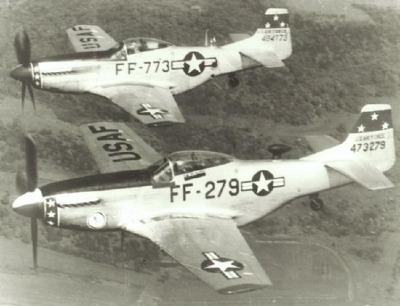
Interesting photo of two Mustangs of the 37th FIS (Fighter Interceptor Squadron) on patrol. Nearest aircraft is P-51D-25-NA 44-73279, the other is a F-6D-25-NT 44-84773, an aircraft that was converted for use as armed Reconnaissance aircraft at the factory in Dallas, TX.
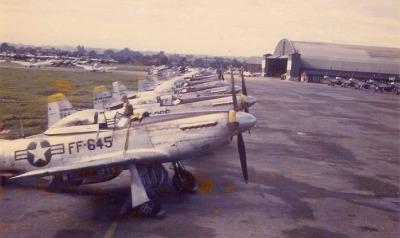
A ramp full of 80th FS F-51's in Japan, 1949.
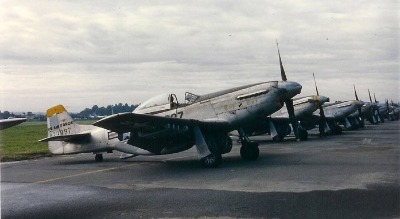
Another view of 80th FS F-51's in Japan, 1949. Nearest a/c is P-51D-25-NA 44-73887.
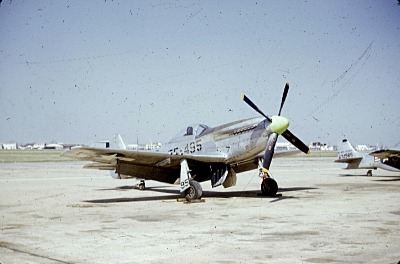
P-51D-25-NA 44-73495 seen here at Love Field, TX, during 1953.
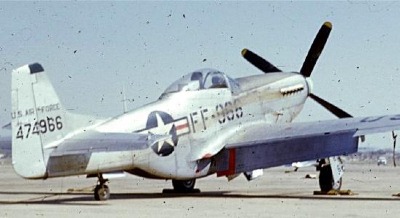
Sharing the ramp with '495 above is 44-74966.
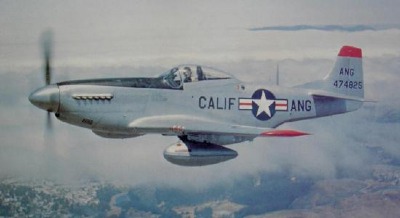
F-51D-30-NA 44-74825 of the 194th FS, California ANG (William T. Larkins).
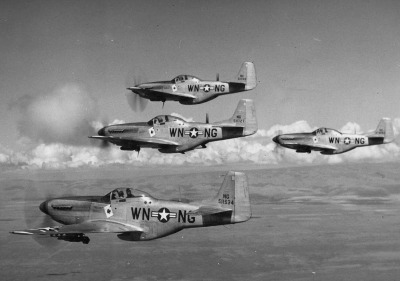
A flight of four F-51D-25-NT Mustangs of the 116th FS, Washington Air National Guard (via Paul Bridgford).
F-51D-25-NT 45-11525 from the 149th Fighter Group, based at Kelly AFB, TX. Photo was taken at Los Angeles International Airport, CA, February 1956 - this aircraft is reported to have been consumed in the Cavalier Facility at Sarasota, FL, during the 60's and most probably was used for a newly built F-51 Cavalier II for the Indonesian Air Force [TNI-AU]. Recovered amongst a number of airframes in Indonesia in 1978, it was registered as N91JB and later N151AF and currently is active on the warbirds circuit in the U.S. (Harold B. Caldwell via Ron Picciani).
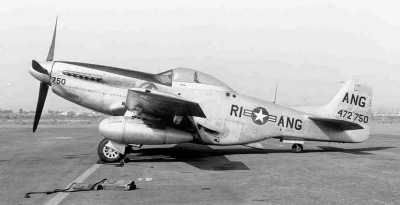
F-51D-25-NA 44-72750 from the 152th FS, Rhode Island Air National Guard - this aircraft also saw service with the 192th FS NV ANG and 194th FS CA ANG before being delivered to the Korean War Theatre in 1950, where it was assigned to the 18th FBG - it then was transferred to the Korean AF [ROKAF] on 19th June 1953 and served there until salvaged in July 1957 (William T. Larkins).
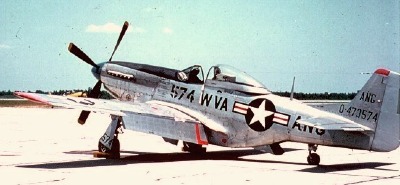
F-51D-25-NA 44-73574 from the 167th FS WV ANG; this a/c later was sold as surplus and was registered N5478V - it crashed and was destroyed, however, on 5th September 1967 at Pottstown, PA.
Formation of F-51D-25-NA's of the 165th FS KY ANG; the 165th FS was assigned to the 123rd FG and based at Standiford Field, KY.
nearest a/c is 44-73155; P-51D-25-NA; durin WW 2 it served in the ETO with 4th FG 334th FS; nickname "My Achin' Back"; code QP-D; then 55th FG 38th FS (post VE-Day); still nicknamed "My Achin' Back"; coded CG-A; then with 355th FG 358th FS; nicknamed "Ole VII"; coded YF-L; returned to the Z.I. during Fall 1945 and later (April 1947) assigned to the 165th FS KY ANG; selected for transfer to the Korean War theatre and eventually transferred to the ROKAF (Korean AF); lost in a flying accident 17th May 1953 -
next a/c is 44-73006; P-51D-25-NA; served with 165th FS KY ANG (assigned 15th April 1947); was also sent to Korea (12th July 1950) where it went into action with 35th FIW but soon was lost to enemy action on 8th October 1950 -
third a/c is 44-73265; P-51D-25-NA; it served with the 165th FS KY ANG (assigned 17th April 1947); last entry survey 4th October 1950 after it crashed on 1st October 1950 due to a ground-collision 7 mi SE of West Point; pilot Richard L. Ross was killed (via Tim Gagnon).
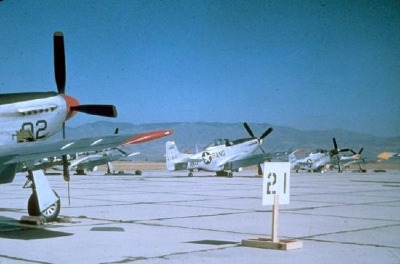
A nice ramp-shot of Indiana ANG F-51D's during a Gunnery Meet.
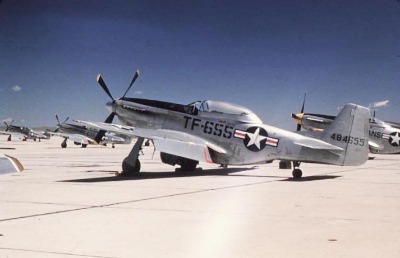
Nice view of a TF-51D-25-NT at a gunnery meet - it is 44-84655, one of the Temco-converted dual trainers; it served with the 140th ABG and also with the 167th FS West Virginia ANG. After retirement, this aircraft was sold to the civil market as N74045 and suffered a landing accident at La Porte, Indiana, on 28th August 1954, but was repaired and sold on 20th February 1958 to Nicaragua where it served as GN98 - again sold o the U.S. and adopting civil reg. N6362T, it then was refurbished and sent to Bolivia as FAB-510, sale date being 10th June 1966; after being damaged in service, it again returned to the U.S. and was sent to Cavalier for rebuild - it was assigned new serial 69-6599 and subsequently sent back to Bolivia under MAP program "Peace Condor". - Visible in the background left are some more USAF F-51D's and behind the tail of 44-84655 is a F-51D of the 127th FS Kansas ANG.
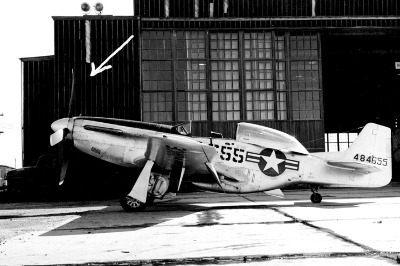
Another photograph of TF-51D-25-NT 44-84655, seen here when attached to the 140th ABG following an accident at Casper, Wyoming on 22nd June 1953 - the arrow points at the bent propeller.
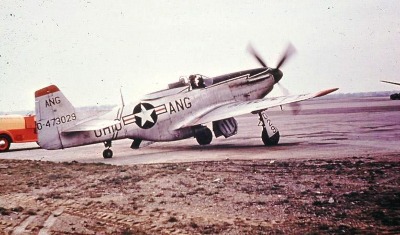
F-51D-25-NA 44-73029 - this aircraft was deployed to the ETO in 1945 and was assigned to the 4th FG 335th FS - post VE-Day, the aircraft was transferred back to the U.S. and later assigned to the 112th FS OH ANG (as seen here) - on 31st May 1958 the aircraft was delivered to the Nicaraguan Air Force as "GN122" - sold back to the U.S. in July 1963, it first adopted civil registration N7999A and later changed to N51JB - this aircraft is still airworthy.
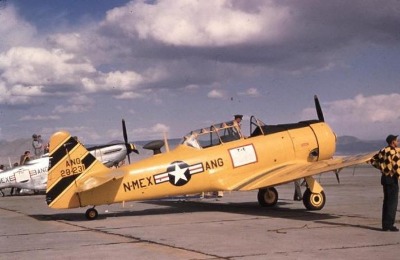
A T-6G Texan, serial 52-8231 of the New Mexico ANG with a F-51D of the same unit in the background (compare with the F-51H photograph below).
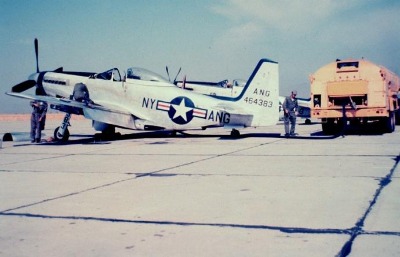
F-51H-5-NA 44-64383 of the 139th FS, New York Air National Guard (via Henk Scharringa).
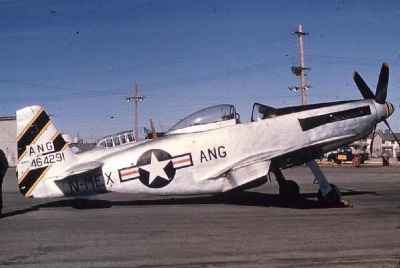
P-51H-5-NA 44-64291 of the 188th FS, New Mexico Air National Guard based at Albuquerque; it saw service there as target-tug 16th November 1952 - 22nd April 1953.
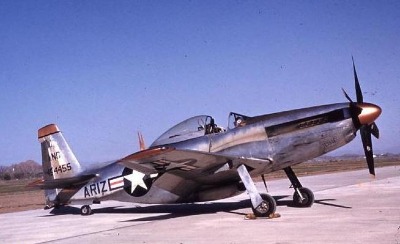
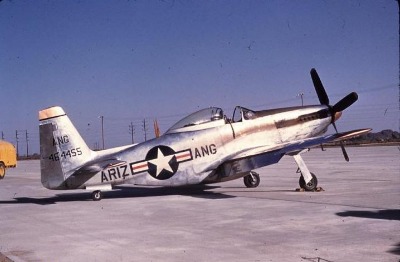
Two views of P-51H-5-NA 44-64455 of the 197th FS Arizona Air National Guard - it was the only P-51H assigned to this unit, and was only operated for one week in December 1952.
Line-up of F-51H's; nearest a/c is F-51H-5-NA 44-64372 of the 134th FS Vermont ANG based at Burlington, VT, with F-51H-10-NA 44-64655 of the 131st FS Massachusetts ANG behind. Photograph was taken in July 1958 (Ron Picciani).
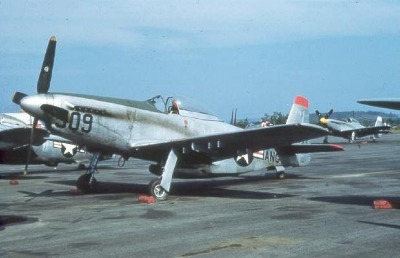
F-51H-10-NA of the 131st FS MA ANG based at Barnes Field, MA - this aircraft was also used by numerous other ANG units during its service-life... - 169th FS IL ANG, 136th FS NY ANG, 162nd FS OH ANG and 166th FS OH ANG.
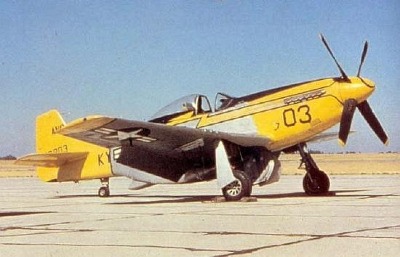
Colorful F-51D-20-NA 44-63803 of the 165th FIS KY ANG. It was used as target-tug during a gunnery-meet.
Following arrangements having been made with the United States Government to purchase 130 North American P-51D Mustangs, the RCAF received its first 32 aircraft during June 1947 with two more following during July of that year; a further five were taken on strength in October 1950, twenty-five during November 1950 and another twenty-five during December 1950. The balance of forty-three aircraft followed during the first three months of 1951.
Serial numbers were allocated in two blocks, 9221 to 9300 inclusive and 9551 to 9600 inclusive.
The Mustangs, designated in Canada as 'Tactical Fighter Mark IV' (undoubtely the 'Mark IV' being used by virtue of the Royal Air Force's similar designation of its P-51D's during World War II), was to equip the following RCAF Auxiliary Fighter Squadrons: Nos. 402 'City of Winnipeg' (code AC), 403 'Calgary' (code PR, replaced by AD in 1954), 417 (Central Air Command Composite Flight' (code CB), 420 'City of London' (code AW, replaced by QJ ca. 1955), 424 'City of Hamilton (code BA, replaced by PV in 1954), 442 'City of Vancouver' (code MH) and 443 'Sea Island' (code PF). In addition to these units, Mustangs were also operated by the Central Flying School [CFS] (code DD), Air Armament School [AAS] (code BZ), No. 1 Flying Training School [FTS] (code GM), Central Experiment & Proving Establishment [CEPE] (code FB) and the Canadian Joint Air Training Center [CJATC] (codes OU and AT). Some Mustangs were also attached to various stations throughout the country, i.e. never apparently attached to any regular Auxiliary unit. Other code-letters carried by Canadian Mustangs were PX and CM, but it is not known to which units these aircraft belonged.
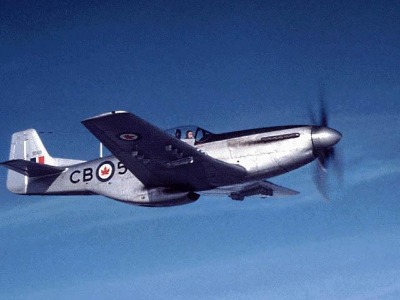
RCAF 9569 in flight
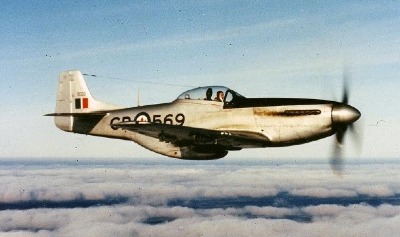
Another view of RCAF 9569 - this a/c was assigned to Trenton Station Flight after service with No. 402 Sqdn - its former USAF-serial was 44-73216, identifying it as a P-51D-25-NA.
The markings laid down for the Mustangs were described as follows: all-natural aluminium finish with red outer wing surfaces, upper and lower, red stabilizers, also upper and lower surfaces, and black anti-glare panel ahead of the cockpit. In practise, however, the red recognition markings to facilitate spotting of a downed aircraft in snow-covered areas, do not appear to have been applied to more than a few aircraft. Initially, the squadrons used callsigns carried over from wartime practice, with a two-letter unit designator, followed by an individual aircraft letter. This practice, however, eventually was dropped in favour of the the two-letter unit designator followed by the last three digits of the aircraft-serial.
Individual unit markings gradually appeared on many Mustangs during the late 1950's, but all RCAF Mustangs retained their natural aluminium finish.
In 1955, the RCAF began to reorganize its Auxiliary units, and late in 1956 started to phase out the first of its Mustangs, the last being struck off strength on 1st November 1960, although only few were kept active during the late 50's, while most of the aircraft had already been put into storage.
Thirty-nine aircraft were lost during service, and many of the survivors were cannibalized to refit the best airframes for sale in the years following their official retirement. Most of the surviving airframes were sold to civilian companies, with the result of quite a number of aircraft surfacing again in various Latin American countires, where they saw further use after refurbishment.
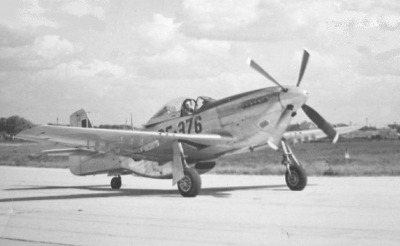
P-51D-30-NA 44-74376 on delivery to Canada on 7th June 1947. The aircraft already has provisional Canadian markings (roundel on fuselage plus fin flash) but retained the USAF buzz-code "PF-376". It became RCAF 9578 and later instructional airframe A582 - s.o.c. date is 3rd February 1953.
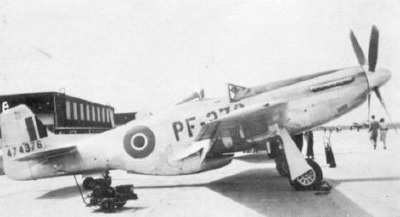
A side-view of the same aircraft (44-74376 = RCAF 9578) showing more details of the delivery markings as described above.
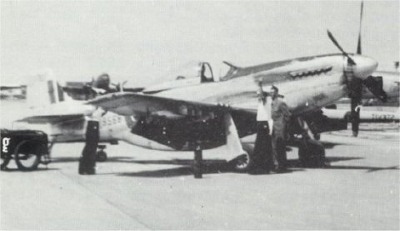
Another interesting photograph, this time RCAF 9569, a P-51D-25-NA built as 44-73216, shortly after being delivered on 7th June 1947 - the provisional nationality markings are still in place, but the USAF buzz-code and the US serial-number on the tail have been removed, being replaced by the RCAF serial behind the fuselage roundel. Soon the markings were standardized.
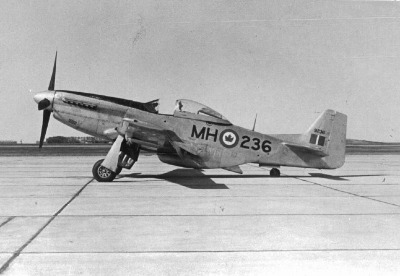
RCAF 9236 of No. 442 Sqdn, coded MH-236; it is former USAAF P-51D-30-NA 44-74468. This aircraft was lost in a crash on 15th August 1955.
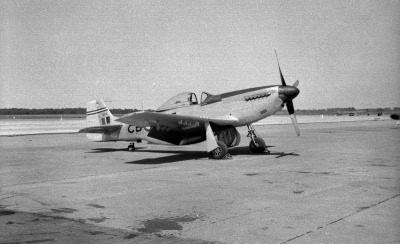
RCAF 9565 coded CB-565 of the Central Air Command Composite Flight (also compare with colour photograph above). This is former P-51D-25-NA 44-72924 and was sold as surplus on 12 June 1958. It was then last noted at Canastota, NY, during 1959, and is belived to be one of the 'scrap-metal' airframes that found their way to the Guatemalan Air Force FAG (via Doug MacPhail).
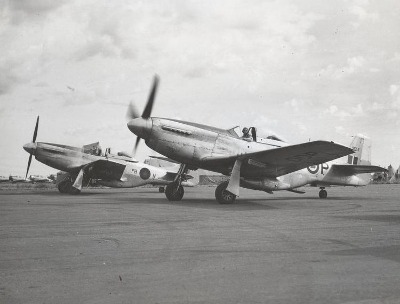
RCAF 9552 coded DD-P of the Central Flying School.
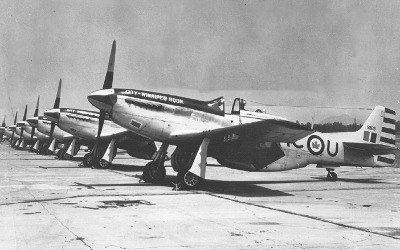
Line-up of No. 402 "City of Winnipeg" Sqdn - nearest aircraft is RCAF 9563, coded AC-U. Former P-51D-25-NA 44-72826, this aircraft was retired in 1960 and later became N6344T (compare with colour photo below).
Another example of No. 402 "City of Winnipeg" Sqdn, but somewhat bent following a belly-landing due to engine failure in 1956. This is RCAF 9273, code AC-273, former 44-74908, which became N1070Z in May 1959, then N965D and eventually N151BP in June 1980. This aircraft is still airworthy.
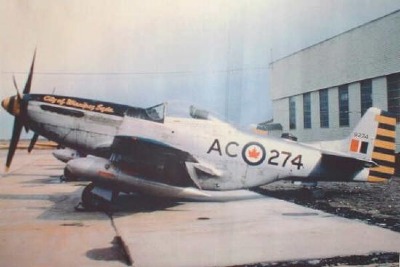
Rare color photo of another No. 402 Sqdn Mustang, seen here ca. 1959, shortly before retirement. It is RCAF 9274, former 44-74008, which became N8676E in May 1959; later registrations include N76AF, N151MR and N51RR.
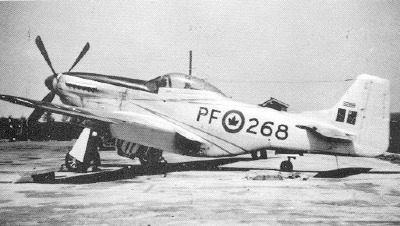
RCAF Mustang 9268 of No. 443 Sqdn, coded PF-268. This is former USAAF P-51D-30-NA 44-74831; the aircraft was later sold to Guatemala where it saw service as FAG-372.
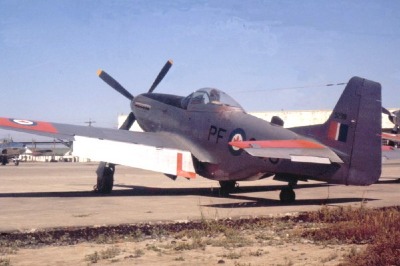
RCAF 9298 of No. 443 Sqdn - former 44-73347, this aircraft was donated to the Canadian War Museum in August 1961.
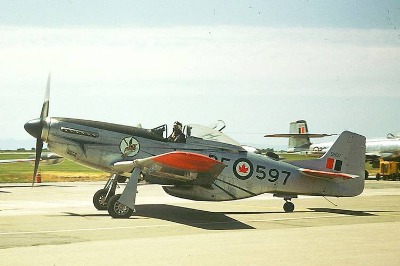
A beautiful shot of RCAF 9597 of No. 443 Sqdn taxying in front of an Avro CF-100 Canuck. Built for the USAAF as 44-74453, this a/c was delivered to the RCAF as 9597 in 1950. After retirement in 1959, it was sold to the U.S. civil market and carried registrations N9150R (Trans Florida Aviation)and N1335 (Ed Weiner) before it crashed on 17th March 1963. Rebuilt with parts of P-51D 44-13903 during the early 80's, it became C-GJCJ in 1987, later N151JP and nowadays flies as N251HR.
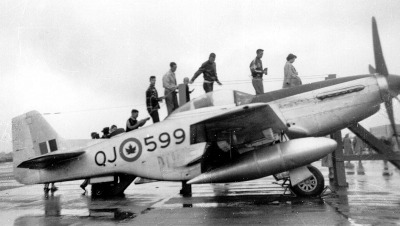
RCAF 9599 QJ-599 of No. 420 "City of London" Sqdn with unusual slim drop-tanks, seen here on display during an RCAF Open Day ca. 1955. This aircraft was lost in a crash on 27th April 1956 (via Doug MacPhail).
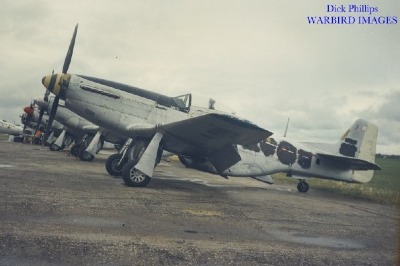
RCAF 9563, former USAAF P-51D-25-NA 44-72826, ex No. 402 "City of Winnipeg" Squadron, coded AC-U, photographed at Carberry, Manitoba, Canada in June 1961, with overpainted markings shortly before being ferried to the U.S. for subsequent use with various private owners (Dick Phillips).
© Martin Kyburz / Swiss Mustangs 2003 - 2019

